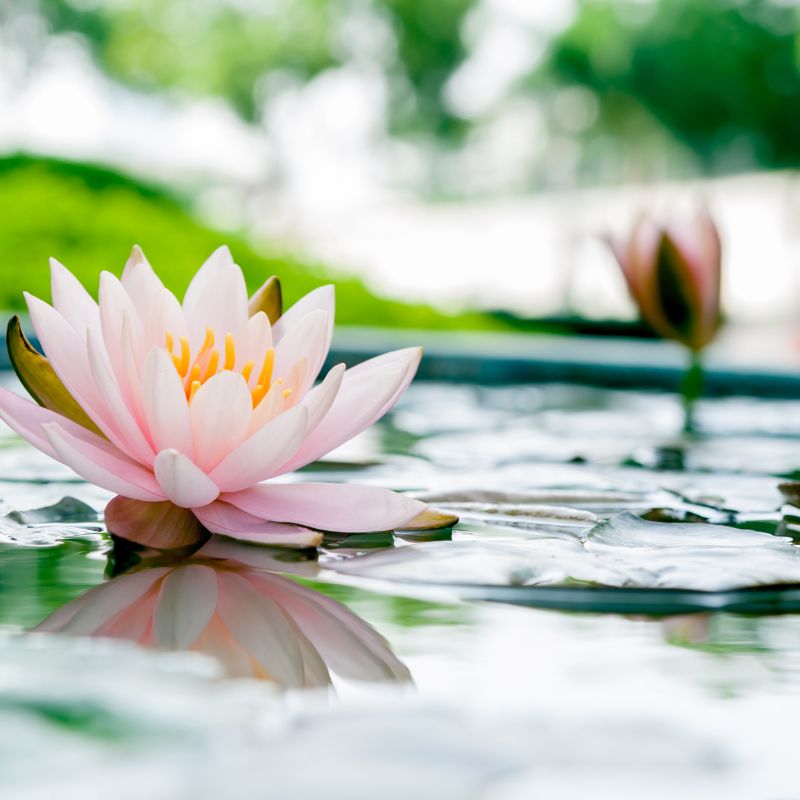Lotus Flower Meaning, Spiritual Symbolism, Color Meaning & More
As I immerse myself in the world of flowers, my gaze is naturally drawn to the exquisite lotus.
In this blog, I invite you to join me on an exploration of the profound lotus flower meaning, the spiritual symbolism it carries, and the intricate language of its colors.
The lotus, with its timeless allure, has not only graced our gardens but also our hearts and minds, serving as a symbol of purity and enlightenment.
Together, let's unravel the hidden stories and the deep significance that the lotus imparts to the tapestry of the natural world.
Key Takeaways
- Purity and Enlightenment: The lotus symbolizes purity, enlightenment, and spiritual awakening. Its growth from muddy waters to blooming in the sun signifies the journey from ignorance to enlightenment.
- Resilience: The lotus's ability to thrive in challenging conditions without being stained by the mud represents resilience and strength in the face of adversity.
- Cultural Significance: The lotus holds great cultural and religious importance, particularly in Hinduism and Buddhism. It symbolizes divine beauty, purity, and the path to spiritual liberation.
- Rebirth and Transformation: The lotus's daily cycle of sinking into the water at night and rising again in the morning is seen as a symbol of rebirth and transformation, mirroring the sun's journey across the sky.
- Mandala Symbolism: Lotus flowers are often used in mandalas, circular geometric patterns with spiritual significance, representing the universe and the interconnectedness of all life.
- Growth and Development: The lotus's different stages of growth, from a closed bud to a fully open flower, symbolize personal growth, progress, and the unfolding of one's potential.
- Colors Matter: Different colors of lotus flowers carry distinct meanings. White symbolizes purity, pink represents divinity and love, blue is associated with the victory of the spirit over the senses, and more.
- Cultural Significance Worldwide: The lotus holds deep cultural significance in various parts of the world, symbolizing purity, commitment, optimism, and resilience across different cultures.
- Cultural Significance Worldwide: The lotus flower holds deep cultural significance in various parts of the world, symbolizing a range of meanings and beliefs in Hinduism, Buddhism, ancient Egypt, China, Vietnam, Japan, Tibet, and even Greek mythology.
- Lotus Flower Tattoos: Lotus flower tattoos are popular, symbolizing purity of the mind, the journey of rising above struggles, and personal development. The different stages of lotus growth can represent various stages in one's spiritual journey.
- National Flower: The lotus is the national flower of India and Vietnam, symbolizing purity, cultural significance, and optimism.
- Symbolism in Art and Culture: The lotus has been a recurring motif in various art forms throughout history, including paintings and sculptures. Its graceful form and rich symbolism have made it a timeless subject for artists.
- Universal Symbolism: The lotus's symbolic meaning has transcended cultural and religious boundaries, becoming a universal symbol of beauty, purity, and spiritual growth.
What Does The Lotus Mean?
- Lotus Growth: The lotus grows in muddy conditions, yet it blooms into exquisite flowers. It is a significant element in various religious ceremonies and holds diverse meanings in Eastern cultures.
- Layered Petals: Lotuses have layered petals radiating from a central core. Despite coming from different plant families, they share similar symbolic meanings, often representing grace and beauty.
- Water Habitat: Lotuses typically grow in ponds and creeks, lending them a mystical quality used in religious ceremonies. In the Victorian flower language, the lotus signifies eloquence.
- Symbolism In Religions: Known as the Padma in Hinduism, the lotus holds symbolic importance in Buddhism, Jainism, Hinduism, and Sikhism. It metaphorically represents life's journey from suffering (mud) to purity (flower).
- Overcoming Challenges: The lotus symbolizes the human journey to overcome life's obstacles and suffering, resulting in wisdom, kindness, and compassion. It encourages personal growth and striving to be the best version of oneself.
RELATED: 137 UPLIFTING SELF-LOVE AFFIRMATIONS TO FIND CONFIDENCE
Exploring The Etymological Origins Of The Lotus
The name ‘Lotus’ is given to different plants, coming from the Latin, lotus, from the Greek lotos.
This was a name given to several plants before it ended up meaning the Egyptian white lotus. It might be Semitic and bears a large part in the mythology of China, Egypt, and India.
The Homeric lotus was later a North African shrub from which people can make wine. The name has also been given to many species of water-lilies and a bean growing in the water.
Moreover, it was once believed to induce forgetfulness, linking to the name, the lotus-eater, and this means the one who finds pleasure in a listless life.
This comes from Greek lotophagoi and is mentioned in Odyssey.

Diving Into The Symbolic Depths Of The Lotus
The Lotus, a symbol of inner strength, tranquility, and purity, holds deep spiritual significance.
Despite its growth in muddy waters, it rises as a beautiful flower, representing the triumph over the material world and the emergence from suffering.
RELATED: 116 UPLIFTING CONFIDENCE QUOTES TO BOOST YOUR SELF-ESTEEM
It symbolizes detachment, urging us to focus on what truly matters.
Lotuses are emblematic of new beginnings and resurrections, as they open in the morning, close at night, and reappear, making them common in funerals, with ties to Egyptian symbolism.
They epitomize purity and cleanliness, emerging untainted from murky waters, signifying the purity of the human soul.
The Lotus opens one petal at a time, mirroring the steps towards spiritual enlightenment and personal progress in life.
Its yellow center reinforces the symbolism of enlightenment. It reminds us to remain true to ourselves, stay grounded, and take pride in our origins.
The Lotus bud once symbolized a virgin, and the fully grown flower represents female strength and nature.
Unveiling The Significance Of Lotus Colors
| Color | Symbolic Meaning |
| White | Purity, spiritual perfection (Buddhism) |
| Blue | Wisdom, knowledge (Buddhism) |
| Gold | Full spiritual enlightenment (Buddhism) |
| Purple | Buddha’s Eightfold Path(Buddhism) |
| Red | Love, compassion (Buddhism) |
| Pink | Essence of Buddha (Buddhism) |
In Hinduism, the religion often uses white lotus. Yet Buddhism reminds us of all the different colors of the flower and their symbolic meanings.
- White Lotus: White lotus symbolizes purity, perfection, and spiritual enlightenment. It is often associated with the highest level of enlightenment in Buddhism.
- Blue Lotus: Blue lotus represents wisdom, knowledge, and the victory of the spirit over the senses. It holds significance in Hinduism and Egyptian mythology.
- Pink Lotus: Pink lotus signifies devotion, love, and the supreme symbol of Buddha's heart. It is the most revered lotus color and represents the history of Buddha.
- Red Lotus: Red lotus symbolizes passion, love, and compassion. It is often associated with the qualities of the heart.
- Purple Lotus: Purple lotus represents mysticism and spirituality, often linked to esoteric traditions and mystical experiences.
- Gold Lotus: Gold lotus symbolizes the achievement of enlightenment, often depicted in the hands of Buddhas or Bodhisattvas.
- Variegated Lotus: Lotuses with multiple colors may combine the meanings associated with each color, offering a more complex and nuanced symbolism.
Discovering The Remarkable Botanical Features Of The Lotus
Variety In Cultivation
Lotus cultivators offer various shades of pink to white flowers with single, semi-double, or double blooms, along with a range of plant sizes.
Use Of Seed Pods
Woody seed pods are commonly used in floral arrangements, adding a unique element. Lotuses exhibit primitive characteristics dating back millions of years in the fossil record.Distinctive Reproductive Structure
The most recognizable feature of the lotus is its ice-cream-cone-shaped reproductive structure. The yellow receptacle contains ovaries, developing into seeds embedded separately in round holes.
Stamen And Stigmas
When fresh, stigmas protrude through the receptacle's holes, while stamens surround the receptacle in multiple rows, resembling a fringe. At the end of each stamen, pollen is produced.
Size And Growth
Lotuses can grow up to approximately 150 cm in height and spread up to 3 meters horizontally, with some rare instances reaching over 5 meters in height. The flower's diameter is around 20 cm, while the leaves can reach a diameter of about 60 cm.
Temperature Regulation
The lotus has a unique ability to regulate its temperature, maintaining it between 86 and 95 degrees Fahrenheit, even when the air temperature drops to 50 degrees Fahrenheit. This thermal regulation is likened to warm-blooded animals, including humans.

Lotus Blossoms For Special Moments
| Occasion | Significance |
| Birthdays | Celebrating a new beginning |
| Weddings | Symbolizing purity and new life together |
| Funerals | Representing rebirth and life's cycles |
| New Beginnings | Starting fresh in a new job or home |
As a result of their beauty and their exciting features, the Lotus has become a popular flower in floral arrangements on several different occasions.
Most commonly, they are a ‘pick-me-up’ flower for those feeling down, or to say ‘Get Well Soon’, ‘Thank You’, or simply that you are thinking of someone during a hard time.
Moreover, since they come in a range of different colors, there are plenty of options and there is a color to suit every occasion or celebration.
Many used it to celebrate anniversaries, birthdays, a new beginning such as a new job or a new home, a birth, graduation, and a whole host of important life events.
You could even use them to decorate your home or office or at a wedding.

| Culture | Symbolic Meanings |
| Hinduism | Purity, enlightenment, rebirth, spiritual growth |
| Buddhism | Purity, love, compassion, wisdom, enlightenment |
| Egypt | Rebirth, creation, power |
| China | Purity, enlightenment, perfection |
| Vietnam | Purity, commitment, optimism, resilience |
Exploring The Cultural Significance Of The Lotus
The lotus flower holds deep cultural significance in various parts of the world, symbolizing a range of meanings and beliefs:
India
In Hinduism, the lotus represents purity, enlightenment, and rebirth. It is often associated with several deities, particularly Lord Vishnu, who is often depicted sitting on a lotus. The lotus is seen as a symbol of spiritual growth, beauty, and detachment from material desires.
Buddhism
The lotus is a powerful symbol in Buddhism. It symbolizes purity of body, speech, and mind, emerging from the muddy waters unstained. Different color lotus flowers carry various meanings: the white lotus symbolizes purity and spiritual perfection, the red lotus symbolizes love and compassion, the blue lotus represents wisdom and knowledge, and the pink lotus symbolizes the Buddha himself.
Egypt
In ancient Egyptian culture, the lotus was associated with rebirth and the Sun. The blue lotus, in particular, was considered a symbol of creation and the cycle of life, as it closed at night and opened in the morning.
China
The lotus is a symbol of purity, enlightenment, and perfection. It is often associated with Buddhism and Confucianism. The lotus is seen as a representation of rising above worldly troubles and achieving enlightenment.
Vietnam
The lotus is Vietnam's national flower and holds cultural and spiritual significance. It is a symbol of purity, commitment, optimism, and resilience. In Vietnamese culture, it represents the beauty and strength that can emerge from adversity.
Japan
In Japan, the lotus is associated with Buddhism and represents the purity of the body, speech, and mind, much like in other Asian cultures. The unfolding petals of the lotus are seen as a metaphor for the gradual unfolding of one's potential.
Tibet
The lotus is an important symbol in Tibetan Buddhism. It is often depicted as a throne for deities, symbolizing their spiritual authority and purity. It is also a powerful symbol of enlightenment and transformation.
Greek Mythology
While not as prevalent as in Eastern cultures, the lotus is associated with the nymph Lotis in Greek mythology. She was transformed into a lotus plant to escape unwanted advances.
Modern Symbolism
Beyond its ancient and cultural significance, the lotus has also become a symbol of beauty, grace, and spiritual growth in contemporary contexts. It is a popular choice for tattoos, artwork, and jewelry, often conveying messages of purity, renewal, and personal development.
Versatile Applications Of The Lotus Flower
The lotus has not only been used for decorating thrones or acting as places of rest for enlightened beings. It also has some important medicinal and edible properties.
The Nymphaea, which is the blue lotus family is great for making a sedative tea and this can help with insomnia.
The Nelumbo family, otherwise known as the sacred Lotus is used for their edible seeds and roots. The American Lotus is also used as a food source.
Middle-aged men can also use the flower to treat erectile dysfunction.
Lotus oil, according to research has a positive effect on blood pressure in that region, and rubbing the oil before intercourse, can help performance.
However, since Sildenafil (Viagra) is now a prescribed medicine for this condition, this use is has become outdated.
Unraveling The Symbolism Behind Lotus Flower Tattoos
As the lotus is so beautiful, with so many delicate and bright colors, it makes for a gorgeous tattoo design.
People regarded the flower as sacred all over the world, especially in Eastern cultures. If you see someone with a tattoo, you know there is a rich symbolism behind it.
As the flower grows in muddy water but remains clean and pure, the tattoo can symbolize purity of the mind and can represent one’s life journey of rising above struggles, to bloom at the end.
The tattoo can also symbolize rebirth as a result of the flower's ability to resurrect itself.
The tattoo serves as an inspiration for those who are recovering from a traumatic experience. As a flower of enlightenment, the tattoo can show the wearers stage of their spiritual journey.
If the tattoo is a flower in full bloom, it is thought to link to full enlightenment but a closed bud links with someone who is still figuring out their spiritual path.
A partly open bloom signifies a spiritual awakening beyond sight. The flower can also serve as a reminder of the commitment of the wearer’s values since the Lotus rises above mud and will not accept defeat.
It shows us how to remain the best version of ourselves and rise above temptations.
Finally, as the Lotus is rooted in mud but can bloom and rise above water on its own and can withstand thousands of years without water, the tattoo can symbolize strength and independence.
Facts And Trivia About Lotus Symbolisms
- Multiple Meanings: The lotus flower is often associated with various symbolic meanings, including purity, enlightenment, rebirth, and spiritual growth. Its symbolism can vary by culture and color.
- Purity Amidst Muck: One of the most common and powerful symbols associated with the lotus is its ability to grow in muddy, murky waters but emerge unstained and pure. This has led to its representation of purity and resilience.
- Buddhist Symbolism: In Buddhism, the lotus is a central symbol. The different stages of a lotus, from the mud to full bloom, are seen as representations of a person's spiritual journey toward enlightenment.
- Variety Of Colors: Different lotus flower colors hold distinct meanings. White symbolizes purity, pink represents the Buddha, blue signifies wisdom, and red symbolizes love and compassion.
- Sacred In Hinduism: The lotus is a sacred flower in Hinduism and is often associated with the goddess Lakshmi, who is the deity of wealth, prosperity, and beauty.
- National Flower Of India: The lotus is the national flower of India and holds deep cultural significance in Indian art, religion, and mythology. It is also the symbol of India's purity.
- Growth Patterns: The lotus has a unique growth pattern, with its flower buds and leaves rising above the water's surface. This distinctive growth has led to its symbolism of emergence and enlightenment.
- Symbol Of Rebirth: Due to its daily cycle of blooming and closing, the lotus has been seen as a symbol of life's continuous renewal and rebirth in many cultures.
- Ancient Egypt: In ancient Egypt, the blue lotus was revered for its associations with the Sun and creation. It was often depicted in art and was used in religious ceremonies.
- Vietnamese National Flower: The lotus is also the national flower of Vietnam, where it symbolizes purity, commitment, and optimism. It is often featured in Vietnamese art and culture.
- Depiction In Art: The lotus has been a recurring motif in various art forms, from paintings to sculptures. Its graceful and elegant form has made it a favorite subject for artists throughout history.
- Healing Properties: In addition to its symbolic importance, some parts of the lotus plant are used in traditional medicine. The roots, seeds, and leaves have been utilized to treat various ailments in different cultures.
- Contemporary Symbolism: Beyond its ancient and cultural symbolism, the lotus has also become a symbol of personal growth, transformation, and purity in modern contexts. It is a popular choice for tattoos and jewelry.
- Sacred Ponds: In some Asian countries, you can find lotus ponds near temples and religious sites. These ponds are often filled with lotus flowers as a symbol of spiritual purity.
- Environmental Significance: The lotus's ability to thrive in polluted waters has inspired environmentalists and scientists to study its unique properties for water purification and environmental restoration.
Final Thoughts
We hope after reading this article you know all you need to know about the Lotus flower and how it's rooted in deep symbolism.
The flower is a beautiful and powerful symbol of enlightenment with endless religious connections.
The symbol of the Lotus has transcended to become universal and can be used by anyone, regardless of their religious background.
Overall, the flower is one of the most beautiful and meaningful flowers in the world, with a rich history and equally rich symbolism behind it.
Frequently Asked Questions
What does the lotus flower symbolize?
The lotus symbolizes various concepts including purity, enlightenment, rebirth, and spiritual growth. Its meanings can vary by culture and color.
What is the significance of the lotus in Buddhism?
In Buddhism, the lotus is a powerful symbol. It represents purity of body, speech, and mind, and the journey from a state of suffering to spiritual awakening.
What do the different colors of lotus flowers represent?
The color of a lotus flower can carry specific meanings. White represents purity, pink symbolizes the Buddha, blue signifies wisdom, and red represents love and compassion.
Is the lotus associated with any specific deities or gods?
Yes, the lotus is often associated with various deities in different cultures. For example, in Hinduism, it is linked to the goddess Lakshmi, while in Buddhism, it is connected to Buddha figures.
Why is the lotus considered a symbol of purity?
The lotus's ability to grow in muddy waters but emerge unstained and pure has led to its association with purity. It represents the idea of maintaining inner purity and grace in the face of challenges.
Is the lotus the national flower of any country?
Yes, the lotus is the national flower of both India and Vietnam, where it holds deep cultural significance.
What is the significance of the lotus's unique growth pattern?
The lotus's growth pattern, with its buds and leaves rising above the water's surface, symbolizes emergence and enlightenment. It signifies the journey from darkness to light.
Are there any medicinal uses of the lotus plant?
Yes, some parts of the lotus plant, such as the roots, seeds, and leaves, have been used in traditional medicine to treat various ailments in different cultures.
Can the lotus be found in art and culture throughout history?
Yes, the lotus has been a recurring motif in various art forms, from paintings to sculptures. Its graceful and elegant form has made it a favorite subject for artists.
How does the lotus inspire environmental efforts?
The lotus's ability to thrive in polluted waters has inspired scientists to study its unique properties for water purification and environmental restoration, offering potential solutions to environmental challenges.

